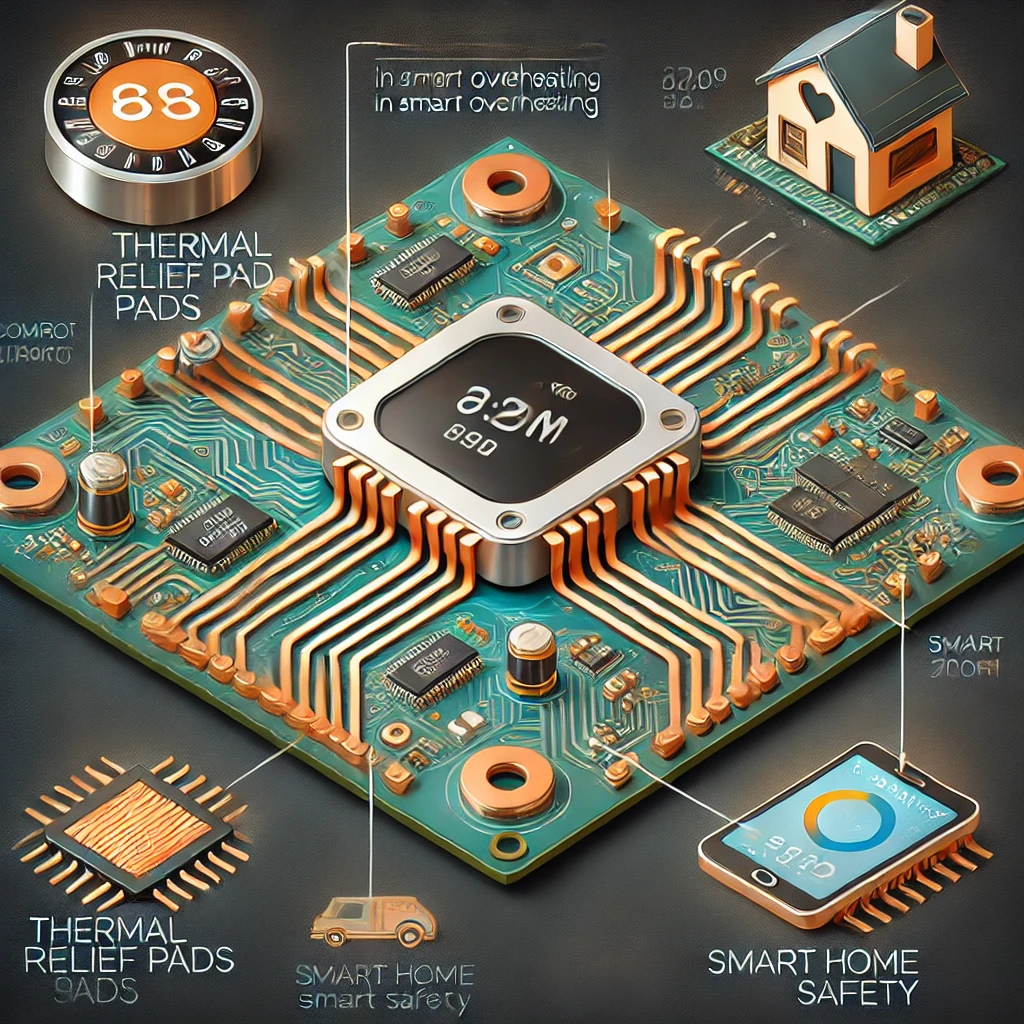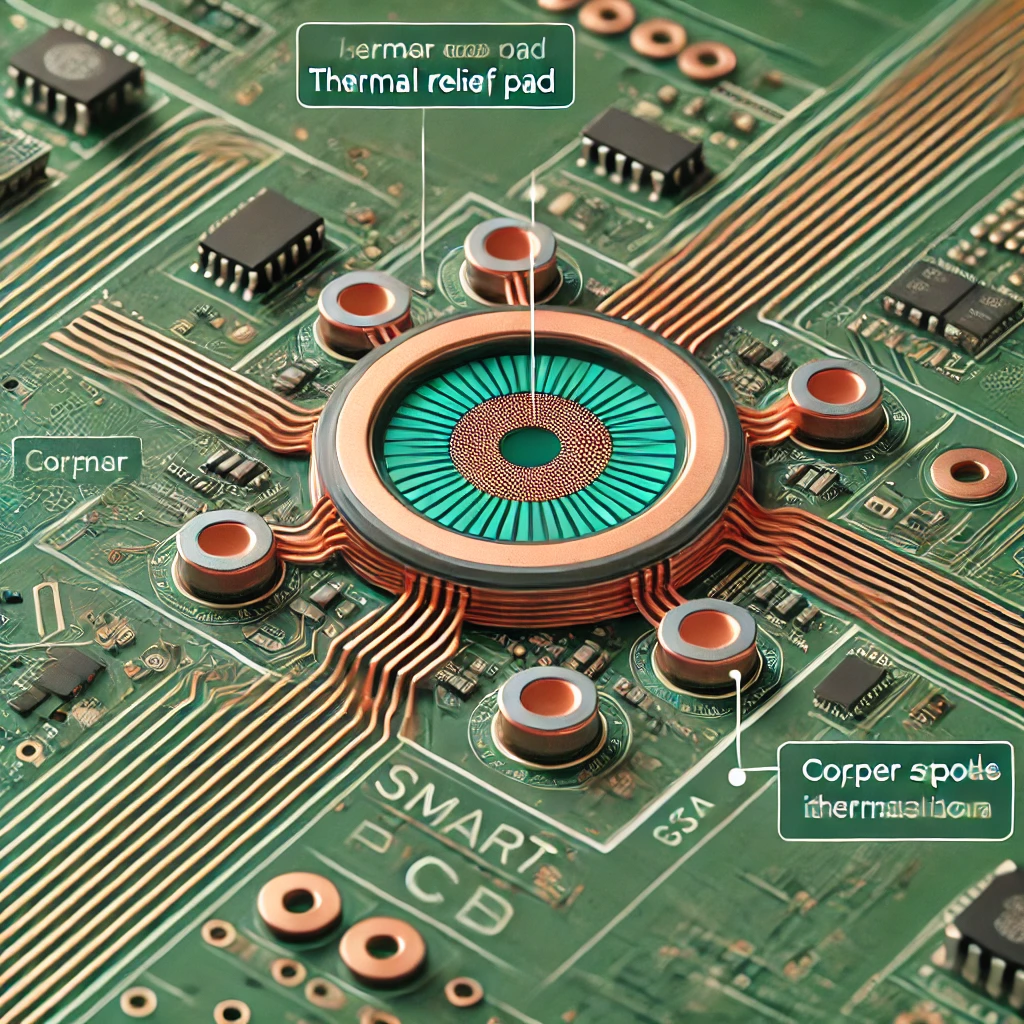
As we continue to integrate more smart devices into our homes, ensuring their safety and reliability has become a pressing concern. Smart homes, once a futuristic concept, are now a reality for millions worldwide. However, with the increasing complexity and power density of these devices comes a heightened risk of overheating, which can lead to malfunctions, fires, or even worse. One often overlooked yet crucial component in mitigating these risks is the thermal relief pad. In this article, we’ll delve into what thermal relief pads are, their importance in smart home safety, and how they contribute to preventing overheating in smart devices.
What Are Thermal Relief Pads?

Thermal relief pads are essentially copper-spoked connectors on printed circuit boards (PCBs) designed to manage heat flow during both the soldering process and device operation. They act as “thermal shock absorbers” for electronics, ensuring that components do not overheat or suffer from cold solder joints. This is particularly important in high-power devices where excessive heat can lead to premature failure or safety hazards.
Imagine a scenario where your smart thermostat is constantly running, managing the temperature of your home. Without proper thermal management, it could overheat, leading to inefficiencies or even a fire. Thermal relief pads help distribute heat evenly, ensuring that such devices operate smoothly and safely.
Why They Matter for Smart Home Safety
Overheating Risks in Smart Devices
The demand for compact, high-power smart devices has skyrocketed. As of 2023, there were over 434.6 million smart devices installed in U.S. homes alone, with this number expected to grow significantly in the coming years. This trend increases the thermal stress on these devices, as they are often designed to be compact and energy-efficient, which can sometimes compromise their cooling capabilities.
For instance, smart speakers like Amazon Echo or Google Home are packed with powerful processors and speakers, all within a small form factor. Without adequate thermal management, these devices could overheat, leading to reduced performance or even safety risks.
Case Study: The Space Heater Incident
A recent Reddit thread highlighted a concerning incident where a space heater melted an outlet due to poor thermal management. While this wasn’t a smart device, it illustrates the potential dangers of overheating. In smart homes, where devices are interconnected and often running continuously, the risk of overheating is even more pronounced.
Thermal relief pads could mitigate such risks by ensuring that high-power smart appliances, like smart thermostats or security cameras, manage heat effectively. This not only prevents overheating but also extends the lifespan of these devices.
Longevity & Energy Efficiency
In 2023, over 60% of new appliances were energy-efficient, reflecting a broader trend towards sustainability. However, these devices often require advanced thermal solutions to maintain their efficiency and safety. Thermal relief pads play a crucial role here by ensuring that energy-efficient devices operate within safe temperature ranges, thereby maintaining their performance and longevity.
For example, gaming consoles, which are essentially high-power computing devices, rely heavily on thermal relief pads to manage heat during intense gaming sessions. This ensures that the console remains stable and efficient, even under heavy load.
Design Best Practices for Smart Home PCBs
When designing PCBs for smart home devices, several best practices can enhance thermal management:
- Use Spoke-Based Pads: For high-current components, such as those found in smart thermostat controllers or security systems, spoke-based thermal relief pads are ideal. These pads help distribute heat evenly across the PCB.
- Optimize Spoke Count/Width: The number and width of spokes in thermal relief pads can significantly affect heat distribution. Optimizing these parameters ensures that heat is managed efficiently without compromising solderability.
- Material Selection: Choosing materials with high thermal conductivity, such as copper, is crucial for effective heat dissipation.
Industry leaders in electronics manufacturing, like GlobalWell PCBA, emphasize the importance of these design considerations to ensure that smart devices operate reliably and safely.
Top 5 Fire-Safe Smart Devices
Explore our list of devices that prioritize thermal management and safety. These devices feature:
- Advanced Cooling Systems: Devices equipped with efficient cooling systems to prevent overheating.
- Thermal Monitoring Capabilities: Smart sensors that detect anomalies in temperature, alerting you to potential fire hazards.
- Certifications from Reputable Safety Organizations: Devices with UL listings or similar certifications ensure they meet rigorous safety standards.
- Examples Include:
- Smart Thermostats: Devices like Nest Learning Thermostat that manage heating and cooling efficiently, reducing the risk of overheating.
- Security Cameras with Thermal Sensors: Cameras that can detect heat anomalies, such as those from Innohome, which can alert you to potential fire risks.
- Smart Plugs with Overheat Protection: Plugs that automatically turn off appliances if they detect excessive heat.
- Smart Smoke Detectors: Devices like Google Nest Protect that provide early warnings and can be monitored remotely.
- Automatic Outlet Controllers: Devices like iGuardFire that can remotely control power to appliances, preventing fires if anomalies are detected.
These devices not only enhance safety but also provide peace of mind by integrating advanced thermal management and monitoring capabilities into your smart home setup.
Enhancing Smart Home Device Safety with Thermal Relief Pads

Thermal relief pads play a crucial role in enhancing the safety of smart home devices by preventing overheating and ensuring reliable soldering. Here are some key points to consider regarding thermal relief pads and their role in smart home safety:
- Enhancing Safety: Thermal relief pads help manage heat effectively, reducing the risk of overheating and potential fires in smart devices. They ensure stable operation and reliable connections, which are critical for safety and performance.
- Latest Trends in Thermal Management: Recent trends focus on integrating advanced thermal management solutions into smart home devices. This includes using thermal relief pads, thermal sensors, and smart materials to optimize heat dissipation and maintain device efficiency.
- Comparison to Other Solutions: Compared to other thermal management solutions like thermal pads or heat sinks, thermal relief pads offer a more integrated approach by balancing heat dissipation with electrical connectivity. They are particularly effective in PCB designs where both thermal and electrical performance are crucial.
- Common Challenges: Challenges in using thermal relief pads include optimizing spoke design for effective heat dissipation without compromising solderability. Additionally, ensuring proper clearance and spacing in PCB layouts can be complex.
- Integration into Existing Systems: Thermal relief pads can be integrated into existing smart home systems by redesigning PCBs to include these pads. This requires careful planning to ensure compatibility with existing components and systems.
By addressing these aspects, thermal relief pads can significantly enhance the safety and reliability of smart home devices, making them an essential component in modern smart home setups.
Frequently Asked Questions
Q: Can thermal relief pads prevent smart home fires?
A: Yes, thermal relief pads can significantly reduce the risk of overheating in high-power devices like smart plugs or HVAC controllers, thereby preventing fires.
Q: Are thermal relief pads used in voice assistants?
A: Absolutely. Devices like Alexa or Google Home use thermal relief pads to manage heat from compact processors, ensuring they operate smoothly and safely.
Q: How do I check if my device has adequate thermal management?
A: Look for certifications like UL listing and avoid overloading circuits. Also, ensure that devices are placed in well-ventilated areas to prevent heat buildup.
Conclusion
Thermal relief pads are unsung heroes in the realm of smart home safety. By ensuring that smart devices manage heat effectively, these pads prevent overheating, extend device lifespan, and enhance overall safety. As we continue to integrate more smart devices into our homes, understanding the role of thermal relief pads is crucial for maintaining a safe and efficient smart home ecosystem.
If you’re interested in learning more about smart home safety or have questions about thermal management in electronics, feel free to share this article and explore our other resources on smart home safety solutions.